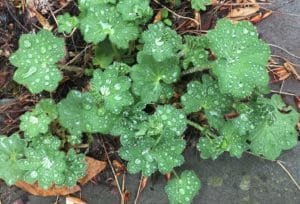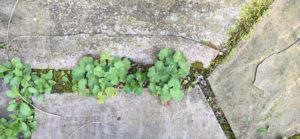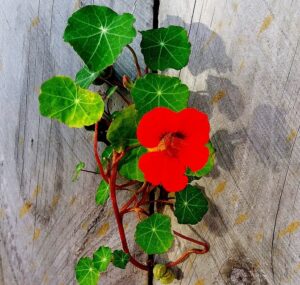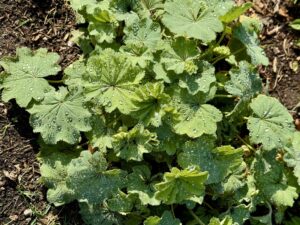Hello, fellow lovers of all things green; I adore clients sending plant photos from their gardens. Tara from Sparta, NJ, sent one of her Lady’s Mantle with the headline Morning Diamonds. “So lovely! I adore the lotus effect. Thank you for sharing,” my note back.
Perfect Spherical Droplets = The Lotus Effect
Indeed, there’s more to gardens than the textures of leaves, plants’ heights, and blooms’ colors. There’s the attraction of bark and stems and the beauty of some flowers and plants when dry or dormant. Another delight is how some plants capture the morning dew with droplets that glisten in the morning sun, like Lady’s Mantle, one of my favorites.

Lady’s Mantle sporting the Lotus Effect

Lady’s Mantle self-seeded in the nooks and crannies.
My Lady’s Mantle (Alchemilla vulgaris) came from a dear friend. They’ve self-seeded in the nooks and crannies of the natural stone walkway— staying miniature and softening the path. The leaves are fan-shaped with tiny teeth at the tips. Though admired mostly for foliage, chartreuse petal-less clusters of flowers adorn her from spring into summer.
It makes a magnificent groundcover plant in sun or shade and thrives in acidic, clay, dry, loamy, and sandy soil in zones 3 to 9. Bambi is not fond of its fuzziness and bitterness and tends to stay clear.
What Creates the Lotus Effect
Lady’s Mantle leaves have tiny soft hairs that resist water, causing droplets to form. The lotus effect is also known as superhydrophobicity. (That’s a mouthful!) Like lotus leaves, Lady’s Mantle doesn’t absorb wetness easily and holds water droplets that clean dirt from leaves. And the reverse is true: the leaves don’t dehydrate readily making them drought tolerant.
The perfect spherical droplets left after a rain or morning dew are eye-catching and oh-so-charming in the garden and the nooks and crannies of the walkway.

Nasturtium Photo by Nareeta Martin on Unsplash
In addition to Lady’s Mantle, there’s Nasturtium (Tropaeolum), Prickly Pear (Optunia), and the wings of insects such as butterflies sport the lotus effect—How we adore their dance pollinating our flower and vegetable gardens. Dragonfly wings do, too—those fascinating creatures with an unusual lifecycle that help control pests.
Nasturtium a Must-Have in Vegetable Gardens
Speaking of nasturtium, I consider it a colorful must-have in vegetable gardens. Nasturtium attracts pests like aphids, keeping them from attacking the veggies. It also deters squash bugs and attracts pollinators, including butterflies, bees, and hummingbirds.
Nasturtium flowers, seed pods, and leaves are edible, too— delightful in salads with their peppery mustard-like taste that deer generally don’t like keeping them away. They’re easy to grow with bold yellow and orange blooms and saucer-shaped foliage, adding color and texture to your vegetable garden. There are trailing varieties (Tropaeolum majus) and bush types, often called dwarf (T. minus).
A brilliant idea just came to me as aphids are still attacking my leatherleaf viburnum. Now, they have moved to other varieties of viburnum nearby. Darn things! I spoke about my dilemma in 2016 when desperate measures called for rejuvenation pruning (link to Reasons to Prune.) And here we are 9 years later, and I’m still battling the suckers, literally sucking the life out of the leaves, making them an unsightly curled mess.

Tara’s Morning Diamonds
Lady’s Mantle is rich in folklore.
So, back to Tara’s Morning Diamonds— Lady’s Mantle is rich with folklore due to the fascination of its lotus effect. Some believe the dew droplets do turn into diamonds. Or the dew can turn metals into gold. Others believe sticking their little toe in the dew during a full moon in May will help you look young and beautiful forever. Legend has it you must be naked when dipping your toe, so surrounding screen trees may be in order (Smile).
But rather than that, let us let go of our judgments of beauty or attachments to what society defines as such. There’s beauty in the aging of plants and people and the cycle of comings and goings, just as water is continually and repeatedly on the move, eventually returning to the ocean, the lowest point, and the cycle continues.
Perhaps I’m talking myself into a new look at the aphids wreaking havoc. They are a food source for beneficial insects and birds. Their honeydew attracts ants that help aerate the soil, break down organic material, and pollinate plants—a beautiful thing.
Garden Dilemmas? AskMaryStone@gmail.com and your favorite Podcast App.
Enjoy more to the story in the Garden Dilemmas Podcast (a soothing 11 minutes):
Links to related Posts and Podcasts
Reasons to Prune – features the story of my aphid invasion.
Ep 29. Aphid Invasion, Beneficial Ladybugs
Benefits and Folklore of Dragonflies – Blog Post


